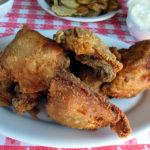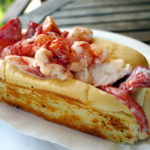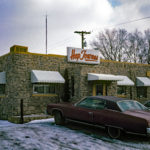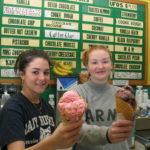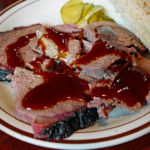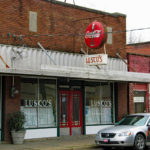One Hundred Years of Barbeque
Santa Barbara, California, smells of jasmine, orchids, and the sea; lesser-known Santa Maria, an hour north by car, is perfumed by the scent of hot beef juices dripping onto flaming oak logs. Every Friday, gusts of aromatic smoke begin to blow across the city's broad avenues and through public parking lots as dozens of local pit men fire up their portable cookers and marshal big chunks of steak in rows atop the grates. All weekend, from midday until after dusk, beef sizzles in the open air; when a steak's crust glistens black, it is forked off and sliced thick. Rimmed with pepper and garlic, the heavy flaps of sirloin are infused with the taste of fire. It is easy meat to slice but still firm, the rosy fibers surrendering a lush bouquet of flavor. This fabulous food is the centerpiece of a feast hallowed on the central California coast, Santa Maria–style barbecue.
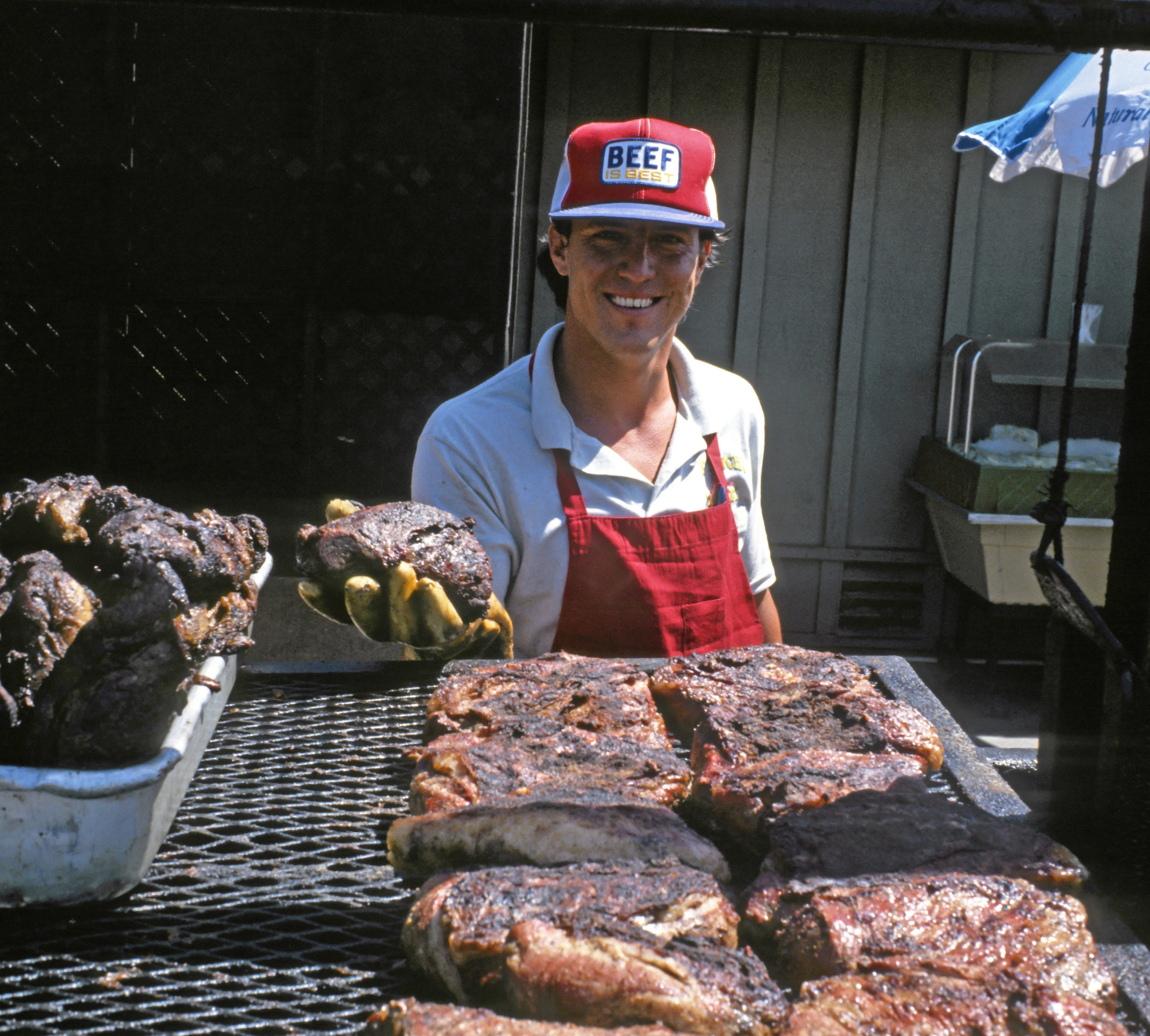
By Jane and Michael Stern
Originally Published 1994 Gourmet Magazine
Santa Barbara, California, smells of jasmine, orchids, and the sea; lesser-known Santa Maria, an hour north by car, is perfumed by the scent of hot beef juices dripping onto flaming oak logs. Every Friday, gusts of aromatic smoke begin to blow across the city’s broad avenues and through public parking lots as dozens of local pit men fire up their portable cookers and marshal big chunks of steak in rows atop the grates. All weekend, from midday until after dusk, beef sizzles in the open air; when a steak’s crust glistens black, it is forked off and sliced thick. Rimmed with pepper and garlic, the heavy flaps of sirloin are infused with the taste of fire. It is easy meat to slice but still firm, the rosy fibers surrendering a lush bouquet of flavor. This fabulous food is the centerpiece of a feast hallowed on the central California coast, Santa Maria–style barbecue.
Once you have developed a yen for it—which will almost surely happen if you grow up in the rolling ranch land south of San Francisco Bay and might likely happen if you merely pass through and have a taste—no other regional barbecue will ever fully satisfy… not even the fall-apart brisket of the Texas hills or the zesty mutton of western Kentucky, and certainly not the chunked pork ‘cue in the Southeast or racks of ribs in Chicago or heaping sandwiches in Memphis. Even if, to fracture a phrase by Will Rogers, you’ve never met a pit-cooked meal you didn’t like, this smoke-scented West Coast wonderment stands out: barbecue deluxe.
Anchored by the heft of slow-cooked red meat, this Santa Maria specialty is more than just a distinct way of grilling or an especially savory cut of beef. It is a whole feast, cooked and served in a ritual way, with a history going back at least a hundred years and a harmony of flavors that evokes the bygone spirit of California cattle country as surely as the sight of a cowboy in a silver-trimmed saddle on a rearing golden palomino.
One pit master told us of a local customer who moved away twenty years ago. On a recent trip back the expatriate sat down and ate thirty-five ounces of barbecued steak for dinner. “He said he wanted to see if it was really as good as he remembered,” the pit man said. “I guess it was, because the next night he came back and ate forty ounces. He was a little guy, but he ate that steak and everything on the table. ”
“Everything on the table”: There’s the key to this tantalizing tradition. Beef is the star, but around it on the plate must be organized a particular complement of side dishes, the most important of which are pinquito beans, also known as poquitos. These pink pillows, half the size of red beans, are grown only in the Santa Maria Valley (no one knows exactly who first planted them, or where they came from). They are cooked long and slow with pork, black pepper, garlic, and onion. After four or five hours in the bean pot, the little pods are silky soft, develop a tongue-teasing snap, and are served in a heap that mingles happily with juices from the adjacent beef. Lengths of toasted, buttered, and garlicked French bread are also de rigueur for mopping the plate. One other fundamental element is salsa, which goes on everything—dolloped on the beans, spread on the bread, and used as relish for the meat. It is usually a mild salsa, mostly tomatoes flavored with onion and perhaps a dash of horseradish and laced with droopy bits of the balmy green chilies known to one and all hereabout by their supermarket brand name, Ortega.
Beyond these basics, a full-bore Santa Maria barbecue will also feature relishes to start—a dish of whole sweet peppers and chili peppers, celery ribs, carrot sticks, and olives—as well as shrimp cocktail made with a few dozen teensy-weensy shrimp and a green salad of head lettuce under thick blue cheese or creamy ranch dressing. There might be a baked potato with sour cream and chives or French fries and possibly some hot creamed macaroni, too. To drink with this big feed, most locals have cold soda or Pinot Noir ordinaire from one of the Santa Barbara County wineries. A demure dish of ice cream or sherbet and a cup of coffee are the customary denouement.
Almost any good cut of beef can be barbecued Santa Maria style. Eat your way through such surrounding towns as Guadalupe, Casmalia, Nipomo, and Los Alamos, and you will encounter oak-grilled prime rib, filet mignon, top sirloin, and rib-eye. The most popular cut, however, is one rarely found outside the Santa Maria area: tri-tip. Named for its triangular shape, tri-tip is a thick, fairly chewy hunk of meat that frequently gets sliced away when butchers are going for pricier, more tender cuts. Cooked slowly over a well-tended fire, perhaps brushed with a wine marinade (a significant source of debate among barbecuists), salted and peppered, and sprinkled with garlic, the tri-tip’s fibers relax, drawing in flavor as they turn tender. Although it will never be as supple as filet mignon or as succulent as densely marbled prime rib, a slice of properly barbecued tri-tip is sheer pleasure to eat—packed with resounding flavor and robust character that sing of California’s frontier days.
Unlike the exemplary barbecue in most of the South and the Southwest, where meat is cooked by indirect heat for many hours in closed pits over smoldering wood, Santa Maria beef is always done in the open, on a grate over a lively fire of oak logs. That’s logs, not charcoal, and only red oak (also known as live oak, from the scrub oak tree that grows from San Diego to San Francisco) will do. It’s a very hard wood, so it not only imparts a distinct taste to the meat and an alluring haze to any place where that meat is being cooked but also burns evenly and slowly enough that a good pit man never need worry about flare-ups scorching a steak. Depending on the intensity of the fire and the grate’s distance from it—both of which an accomplished barbecuist adjusts throughout the process—a tri-tip requires anywhere from two to four hours to reach its flavor peak. (A single-serving filet or New York strip an inch thick will be cooked medium-rare in a mere fifteen minutes.)
Ritualized as this barbecue may be, it seems that nearly everyone who does it adds a personal twist to the formula. We were astonished to discover, after many model Santa Maria—style meals in the region, that the El Rancho Chuck Wagon Bar-B-Q, a merry weekend-only stand next to the parking lot of the El Rancho Market on Route 246 east of Solvang, considers itself to be in a different league than that of the barbecues a half hour north in Santa Maria. The food looked utterly familiar—the tri-tips are cooked over red oak and classically seasoned with garlic, salt, and pepper (no marinade) —but pit master Adam Patterson insisted that he makes Santa Ynez style barbecue, not Santa Maria—style. The difference? He pointed to his fire, which burns lower, and his grate, which is higher, meaning that his meat cooks longer (a full four hours). Santa Ynez beans, he noted, are not pinquitos: They are bigger and more peppery than those served farther north.
El Rancho is the only place we discovered that claims to make Santa Ynez—style. But it is a variant you definitely want to know about for any eating tour of the region. The longer cooking time means that the tri-tip is less crusty on the outside but its insides are succulent. The finished piece of meat looks pumped full of juice, and, when you ease a knife down through it, natural gravy flows. One bicoastal customer stops at the stand one Friday a month to buy a dozen grilled tri-tips, at ten dollars a piece. He has them wrapped well, then hauls his loot to LAX for a red-eye flight to New York and a Saturday banquet enjoyed by a few dozen East Coast aficionados of oak-cooked beef.
In addition to the classic tri-tip, there are other good things smoking on Patterson’s grill: beef ribs and pork ribs by the slab, spicy sausage, and half chickens that are available done or well-done, the latter also known as sunburned.
Meat and beans are sold outdoors at Patterson’s pit, which fronts the highway; for salsa, French bread, and other fixings, you must shop inside El Rancho, a large market that features all the appropriate side dishes ready to eat. (El Rancho also has a butcher’s case featuring tri-tips and, when available, supplies of Susie Q’s Genuine Santa Maria—Style Seasoning for do-it-your-selfers, as well as dried pinquito beans.) For travelers who want to make a meal of the Chuck Wagon barbecue that adorns El Rancho’s parking lot, the question is, where? Because El Rancho doesn’t have a license to serve meals, there are no tables, no plates, and no utensils available—everything is sold to go. A majority of customers are residents who take barbecue home for an easy weekend supper; but for passers-through, Adam Patterson has a list of nearby parks with picnic facilities. One dining spot he especially likes to suggest is the nearby Santa Ynez Winery, with a tasting room that features local Pinot Noir.
A lot of Santa Maria barbecue is sold at mobile pits like El Rancho’s that are set up primarily for the take-home trade: whole tri-tips, quarts of beans, cups of salsa. However, there are plenty of cook wagons lining the streets of north Santa Barbara County towns on weekends that will indeed put a meal on a plate (paper), with a fork (plastic), and provide a place to eat (usually a portable picnic table a few yards from the cooker). Roughing it is part of the fun of this sloppy culinary jamboree. Some vendors have health department certification to serve meals, some do not; despite the niceties of the law, no one we spoke to expects authorities to come along and arrest pit men and customers caught eating illegal fare. Local citizens have been enjoying their barbecue this way for too long to allow bureaucrats to tell them just where they are permitted to do so.
It isn’t only good food that makes these meals so dear to the people of California’s ranching coast. In these parts, barbecue’s appeal derives also from its virtue. Nearly all the weekend pits in Santa Maria are operated for charity’s sake, which means you do good by eating well. Four local soccer clubs, for instance, join forces and set up a cooker at the corner of El Camino and Broadway, selling deliciously messy sandwiches of sliced tri-tip and salsa heaped onto sections of buttered French bread, the proceeds from which go toward uniforms and team trips. Women of the Moose (the ladies’ auxiliary of the fraternal order) has an immensely popular monthly barbecue stand at the town’s go-cart racetrack. In the big shopping center on Broadway, the Lions Club Valley Christian Boosters operates a huge pit (with tables); it has proven so successful that the club recently expanded into six-day-a-week service out of a nearby doughnut shop.
Few of the people turning tri-tips and ladling out heaps of pinquito beans at these ubiquitous beef bazaars are professional chefs. Most are simply neighbors who have come together to cook in a common cause. That makes a lot of sense considering that this is the way Santa Maria barbecue began, at least a hundred years ago. The custom throughout the West in those days was for adjacent ranches to join together and bring in all their cattle for a communal spring roundup. It was a time of year that meant hard work for the cowhands, known in this part of the world as “vaqueros” (the Spanish word from which “buckaroo” evolved); they spent long days roping, branding, and ear-notching calves.
When the work was done, ranchers and vaqueros from all the outfits gathered to celebrate their accomplishments. Of course, they ate beef, cut into big hunks and skewered on poles over open pits of burning oak. Pinquito beans and salsa were on the bill of fare from the beginning—a legacy of the Spanish heritage of many of the ranchers. The celebratory spirit of the meal made it a natural favorite for any kind of great outdoor community feast. Francess Lantz, who wrote about the local beef obsession for Santa Barbara Magazine two years ago, reported that oak-pit barbecue has been part of Santa Maria Independence Day celebrations since 1904.
Ranches still have spring roundups, and many continue to celebrate the event with an annual open-pit fiesta. But in the 1920s, Santa Maria–style barbecue came in off the range. It happened at the Santa Maria Club, founded by cattlemen and oilmen as a place to gamble, wheel and deal, enjoy a then-taboo libation, and partake in a once-a-month stag dinner for club boarders and local gents. Hunks of prime rib four inches thick were cooked for a couple of hours on an open pit over red oak. The meat was served with salad, pinquitos, creamed macaroni, garlic bread, and salsa, as well as bootleg hooch. Outdoor barbecues had long been common on ranches, and eventually on street corners, but the Santa Maria Club, which was private, was the first place that regularly served the beloved meal indoors, on china, with cloth napkins and permanent utensils.
Not until after World War II did restaurants in the area start offering Santa Maria barbecue. The oldest one still operating today began in 1952, when Frank Ostini bought an old hotel, called The Hitching Post, in the town of Casmalia, a lively cattle center back in the pre-statehood days of the vast California ranchos. He kept the name and made steak his specialty. He had no menu; customers had no choice whatever. Everybody ate the particular cut of meat Mr. Ostini happened to be making that night—a T-bone, a sirloin, or a filet mignon, served with the full assortment of Santa Maria side dishes. In the 1950s, observes Frank’s son Bill, who is now The Hitching Post’s proprietor, Casmalia was something of a boomtown. “Fourteen hundred people,” he recalls. “We had oil, cattle, a train depot, a harbor just to the west, and a busy Main Street.” Now the oil business is gone, as is the train service, and Vandenberg Air Force Base looms over the shore. “I am the show in town now,” Bill notes, scanning a near empty Main Street. But there is scarcely a place to park around his restaurant, which is thronged every night with people who come from miles around to enjoy what many consider the best steaks on earth.
The Hitching Post’s top sirloin is grand—pungent with age (five weeks, minimum) and oozing juice—but the filet mignon is even better. Although it doesn’t have the same beefy wallop as the sirloin, its deli-cate fibers seem to glow with the flavor of burning wood and with the piquant smack of a wine vinegar and oil marinade that is also applied as the meat cooks.
“We’ve had people throwing hundred-dollar bills at us, trying to get the recipe for that marinade,” Bill Ostini says of the magic potion developed by his father. “Sometimes I make bottles of it up for friends. Other than that, all we use is salt, pepper, and garlic. The real trick is in how the steaks are handled. You’ve got to know how to cook which steak which way—some are made to be cooked rare; some, well-done. It depends on the marbling and how much age they have. It takes two to three years to train a cook to do it the right way. I barely trust my brother, Bobby, and he’s been doing it for seven years. Cutting and cooking steaks is practically a lost art.” You can watch the cooking aspect of this art performed at The Hitching Post, where the grill is located behind a glass wall that allows a view of Bill or his brother raising and lowering the grate; rearranging wood underneath and steaks on top; and basting, sprinkling, and skillfully prod-ding each piece of beef.
Steak at The Hitching Post is part of a full dinner, which is the archetypal Santa Maria repertoire save for one odd exception—no beans. “My dad refused to do beans, simply because everybody else does them,” Bill explains with a shrug. “So we’ve kept that tradition.” Instead you get potatoes, baked or French-fried. The ambiance is sheer cattle country delight: a big, dimly lit roadhouse with linoleum floors and red tablecloths, each table supplied with a basket full of cellophane-wrapped saltines. Above the bar a television is always playing; the mirror is plastered with decals from NASA, Voyager, and the Army Corps of Engineers; a bison head on one wall wears a Buffalo Bills cap. In the dining room there are mounted deer heads and old black-and-white family photos of Bill and Bobby on hunting and fishing trips with their dad when they were young. The hallway that leads to the rest rooms is lined with cattle hides.
The cattle-country theme is even more pronounced at the Far Western Tavern, one of the other great Santa Maria–style barbecue restaurants, located in the town of Guadalupe a few miles west of Santa Maria. Here the dining room features a spectacular suite of huge brown-and-white cow-hide curtains. (In fact, there are two full sets, so when one is being dry-cleaned patrons needn’t look out through undraped windows.) Meals are served on cowboy-fantasy dishware festooned with little images of brands, spurs, and cows’ heads. The wall across from the bar is one sweeping mural of ranch life. Other displays include a portrait of Will Rogers, a poster that shows how to break a wild pony, an autographed 8 by 10 of Ralph Edwards (from This Is Your Life) praising the steaks, and a photograph of the all-woman bowling team sponsored by the tavern, along with a display of their trophies.
Clarence Minetti, the proprietor of the Far Western, is an old-timer; seventy-seven years old, he is an authority on the evolution of local barbecue and is himself a rancher. The oak-cooked “bull’s eye” steak that is the tavern’s specialty is often made from cattle raised on Mr. Minetti’s Corralitos Ranch, twelve miles of nearby coastal pastureland. The barbecue is classic. Especially noteworthy are the beans: firm, luscious pinquitos made according to a bacon-rich recipe developed by Mrs. Minetti in the family’s home kitchen.
Even if you can’t come around to Santa Maria for a taste of its unique community meal, there are ways to approximate it at home. You can duplicate Far Western beans almost exactly, thanks to Mr. Minetti’s daughter, Susan Righetti, who has begun a mail-order business featuring dried local pinquitos, along with packets of bean seasoning. She also markets Santa Maria—style seasoning for beef: a blend of garlic, pepper, salt, and parsley. All that’s needed to complete the picture is some live-oak wood and a pit; a selection of good steaks, French bread, and a favorite salsa; and a passel of friends to enjoy it all with. Cowhide drapes in the dining room and plates with pictures of spurs and lassos on them are optional.
Far Western Tavern
Guadalupe, California (new location)
El Rancho
Discuss
What do you think of One Hundred Years of Barbeque?
Related Articles
Stroud’s
By Jane and Michael Stern Originally Published 1995 Gourmet Magazine Chicken...
The Lobster Roll Honor Roll
Maine is the only state in America that features a picture of cooked food on its license...
Meat-And-Three
A few years back, country singer Ray Stevens invited a New York friend to join him at one of...
Top 12 favorite Ice Cream Scoops
WITH THE EXCEPTION of the hot dog bun, there has never been an edible invention as...
Top 5 BBQ Restaurants | Western Kentucky
Get yourself to Western Kentucky for great BBQ I see the food shows on TV where...
Best restaurants in Greenwood, MS | Hot Licks Delta Style
Ever since we first ate margarine-sauced pompano at Lusco’s, in Greenwood,...

